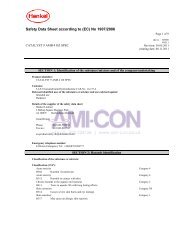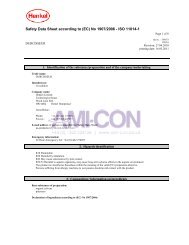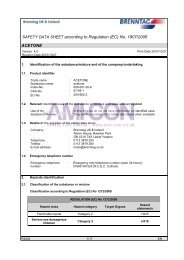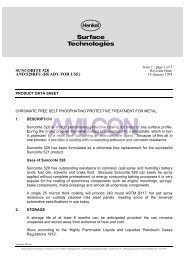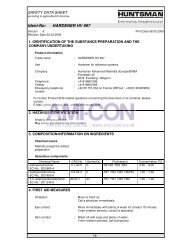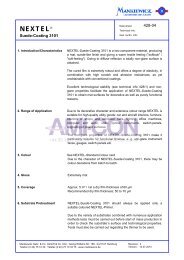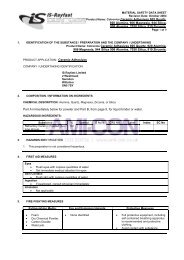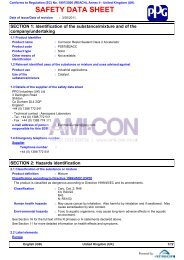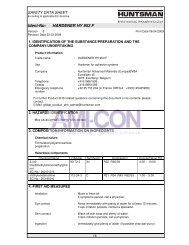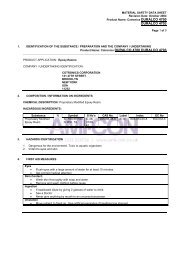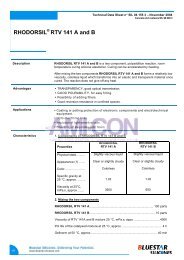8603 ARADUR HY 917 (English (GB)) Huntsman SDS ... - AMI-CON
8603 ARADUR HY 917 (English (GB)) Huntsman SDS ... - AMI-CON
8603 ARADUR HY 917 (English (GB)) Huntsman SDS ... - AMI-CON
You also want an ePaper? Increase the reach of your titles
YUMPU automatically turns print PDFs into web optimized ePapers that Google loves.
Conforms to Regulation (EC) No. 1907/2006 (REACH), Annex II - United Kingdom (UK)Chemical formulaSAFETY DATA SHEET:<strong>ARADUR</strong> <strong>HY</strong> <strong>917</strong>SECTION 1: Identification of the substance/mixture and of thecompany/undertaking1.1 Product identifierProduct name: <strong>ARADUR</strong> <strong>HY</strong> <strong>917</strong>EC number: Not available.CAS number : 26590-20-5Product code : 00068176Product descriptionOther means ofidentification: Formulated hardener for structural composites: 26590-20-5C9-H10-O31.2 Relevant identified uses of the substance or mixture and uses advised againstNot available.Identified usesUses advised againstNot available. -Reason1.3 Details of the supplier of the safety data sheetSuppliere-mail address of personresponsible for this <strong>SDS</strong>: <strong>Huntsman</strong> Advanced Materials (Europe)BVBAEverslaan 453078 Everberg / BelgiumTel.: +41 61 299 20 41Fax: +41 61 299 20 40: Global_Product_EHS_AdMat@huntsman.com1.4 Emergency telephone numberSupplierTelephone number : EUROPE: +32 35 75 1234France ORFILA: +33(0)145425959ASIA: +65 6336-6011China: +86 20 39377888Australia: 1800 786 152New Zealand: 0800 767 437USA: +1/800/424.9300SECTION 2: Hazards identification2.1 Classification of the substance or mixtureProduct definition : Mono-constituent substanceClassification according to Regulation (EC) No. 1272/2008 [CLP/GHS]Eye Dam. 1, H318Resp. Sens. 1, H334Skin Sens. 1, H317Classification according to Directive 67/548/EEC [DSD]Xi; R41R42/43See Section 16 for the full text of the R phrases or H statements declared above.See Section 11 for more detailed information on health effects and symptoms.Date of issue / Date of revision : 3/3/2011.1/13
Conforms to Regulation (EC) No. 1907/2006 (REACH), Annex II - United Kingdom (UK)<strong>ARADUR</strong> <strong>HY</strong> <strong>917</strong>Date of printing : 3 March 2011M<strong>SDS</strong> no.: 00068176Date of issue : 3 March 2011Version : 1.01SECTION 2: Hazards identification2/132.2 Label elementsHazard pictograms :Signal word :Hazard statements :Precautionary statementsPrevention :Response :Storage :Disposal :Supplemental labelelementsSpecial packaging requirementsContainers to be fittedwith child-resistantfasteningsTactile warning of dangerDangerCauses serious eye damage.May cause allergy or asthma symptoms or breathing difficulties if inhaled.May cause an allergic skin reaction.Wear protective gloves: >8 hours (breakthrough time): butyl rubber, Ethyl VinylAlcohol Laminate (EVAL). Wear eye or face protection. Avoid breathing vapour.If experiencing respiratory symptoms: Call a POISON CENTER or physician. IF INEYES: Immediately call a POISON CENTER or physician.Not applicable.Dispose of contents and container in accordance with all local, regional, national andinternational regulations.: Not applicable.::Not applicable.Yes, applicable.2.3 Other hazardsSubstance meets thecriteria for PBT accordingto Regulation (EC) No.1907/2006, Annex XIIISubstance meets thecriteria for vPvB accordingto Regulation (EC) No.1907/2006, Annex XIIIOther hazards which donot result in classificationSubstance/mixtureProduct/ingredientname: PBT: No.P: No. B: No. T: No.: vPvB: No.vP: No. vB: No.::Not available.SECTION 3: Composition/information on ingredientsmethyltetrahydrophthalicanhydrideMono-constituent substanceIdentifiersCAS: 26590-20-5 60 -100% 67/548/EEC Regulation (EC) No. Type1272/2008 [CLP]Xi; R41R42/43See section 16 forthe full text of the R-phrases declaredaboveClassificationEye Dam. 1, H318Resp. Sens. 1, H334Skin Sens. 1, H317See Section 16 for thefull text of the Hstatements declaredabove.[A]Date of issue / Date of revision : 3/3/2011.2/13
Conforms to Regulation (EC) No. 1907/2006 (REACH), Annex II - United Kingdom (UK)<strong>ARADUR</strong> <strong>HY</strong> <strong>917</strong>Date of printing : 3 March 2011M<strong>SDS</strong> no.: 00068176Date of issue : 3 March 2011Version : 1.013/13SECTION 3: Composition/information on ingredientsThere are no additional ingredients present which, within the current knowledge of the supplier, are classified andcontribute to the classification of the substance and hence require reporting in this section.Type[A] Constituent[B] Impurity[C] Stabilising additiveOccupational exposure limits, if available, are listed in Section 8.SECTION 4: First aid measures4.1 Description of first aid measuresEye contact: Get medical attention immediately. Call a poison center or physician. Immediatelyflush eyes with plenty of water, occasionally lifting the upper and lower eyelids.Check for and remove any contact lenses. Continue to rinse for at least 10 minutes.Chemical burns must be treated promptly by a physician.Inhalation:Get medical attention immediately. Call a poison center or physician. Removevictim to fresh air and keep at rest in a position comfortable for breathing. If it issuspected that fumes are still present, the rescuer should wear an appropriate maskor self-contained breathing apparatus. If not breathing, if breathing is irregular or ifrespiratory arrest occurs, provide artificial respiration or oxygen by trained personnel.It may be dangerous to the person providing aid to give mouth-to-mouthresuscitation. If unconscious, place in recovery position and get medical attentionimmediately. Maintain an open airway. Loosen tight clothing such as a collar, tie,belt or waistband. In the event of any complaints or symptoms, avoid furtherexposure.Skin contactIngestion::Get medical attention immediately. Call a poison center or physician. Wash withplenty of soap and water. Remove contaminated clothing and shoes. Washcontaminated clothing thoroughly with water before removing it, or wear gloves.Continue to rinse for at least 10 minutes. Chemical burns must be treated promptlyby a physician. In the event of any complaints or symptoms, avoid further exposure.Wash clothing before reuse. Clean shoes thoroughly before reuse.Get medical attention immediately. Call a poison center or physician. Wash outmouth with water. Remove dentures if any. Remove victim to fresh air and keep atrest in a position comfortable for breathing. If material has been swallowed and theexposed person is conscious, give small quantities of water to drink. Stop if theexposed person feels sick as vomiting may be dangerous. Do not induce vomitingunless directed to do so by medical personnel. If vomiting occurs, the head shouldbe kept low so that vomit does not enter the lungs. Chemical burns must be treatedpromptly by a physician. Never give anything by mouth to an unconscious person. Ifunconscious, place in recovery position and get medical attention immediately.Maintain an open airway. Loosen tight clothing such as a collar, tie, belt orwaistband.Protection of first-aiders: No action shall be taken involving any personal risk or without suitable training. If it issuspected that fumes are still present, the rescuer should wear an appropriate maskor self-contained breathing apparatus. It may be dangerous to the person providingaid to give mouth-to-mouth resuscitation. Wash contaminated clothing thoroughlywith water before removing it, or wear gloves.4.2 Most important symptoms and effects, both acute and delayedPotential acute health effectsEye contactInhalationSkin contactIngestionOver-exposure signs/symptoms:Causes serious eye damage.: May give off gas, vapor or dust that is very irritating or corrosive to the respiratorysystem. May cause allergy or asthma symptoms or breathing difficulties if inhaled.: May cause an allergic skin reaction.: May cause burns to mouth, throat and stomach.Date of issue / Date of revision : 3/3/2011.3/13
Conforms to Regulation (EC) No. 1907/2006 (REACH), Annex II - United Kingdom (UK)<strong>ARADUR</strong> <strong>HY</strong> <strong>917</strong>Date of printing : 3 March 2011M<strong>SDS</strong> no.: 00068176Date of issue : 3 March 2011Version : 1.014/13SECTION 4: First aid measuresEye contactInhalationSkin contactIngestion: Adverse symptoms may include the following:painwateringredness:::Adverse symptoms may include the following:wheezing and breathing difficultiesasthmaAdverse symptoms may include the following:pain or irritationrednessblistering may occurAdverse symptoms may include the following:stomach pains4.3 Indication of any immediate medical attention and special treatment neededNotes to physician : Treat symptomatically. Contact poison treatment specialist immediately if largequantities have been ingested or inhaled.Specific treatments: Symptomatic treatment and supportive therapy as indicated. Following severeexposure the patient should be kept under medical review for at least 48 hours.SECTION 5: Firefighting measures5.1 Extinguishing mediaSuitable extinguishingmediaUnsuitable extinguishingmedia::Use an extinguishing agent suitable for the surrounding fire.None known.5.2 Special hazards arising from the substance or mixtureHazards from thesubstance or mixture: In a fire or if heated, a pressure increase will occur and the container may burst.Hazardous thermaldecomposition products:Decomposition products may include the following materials:carbon dioxidecarbon monoxide5.3 Advice for firefightersSpecial precautions forfire-fightersSpecial protectiveequipment for fire-fighters::Promptly isolate the scene by removing all persons from the vicinity of the incident ifthere is a fire. No action shall be taken involving any personal risk or without suitabletraining.Fire-fighters should wear appropriate protective equipment and self-containedbreathing apparatus (SCBA) with a full face-piece operated in positive pressuremode. Clothing for fire-fighters (including helmets, protective boots and gloves)conforming to European standard EN 469 will provide a basic level of protection forchemical incidents.SECTION 6: Accidental release measures6.1 Personal precautions, protective equipment and emergency proceduresFor non-emergencypersonnel: No action shall be taken involving any personal risk or without suitable training.Evacuate surrounding areas. Keep unnecessary and unprotected personnel fromentering. Do not touch or walk through spilt material. Do not breathe vapour or mist.Provide adequate ventilation. Wear appropriate respirator when ventilation isinadequate. Put on appropriate personal protective equipment.Date of issue / Date of revision : 3/3/2011.4/13
Conforms to Regulation (EC) No. 1907/2006 (REACH), Annex II - United Kingdom (UK)<strong>ARADUR</strong> <strong>HY</strong> <strong>917</strong>Date of printing : 3 March 2011M<strong>SDS</strong> no.: 00068176Date of issue : 3 March 2011Version : 1.015/13SECTION 6: Accidental release measuresFor emergency responders :If specialised clothing is required to deal with the spillage, take note of anyinformation in Section 8 on suitable and unsuitable materials. See also theinformation in "For non-emergency personnel".6.2 Environmentalprecautions:Avoid dispersal of spilt material and runoff and contact with soil, waterways, drainsand sewers. Inform the relevant authorities if the product has caused environmentalpollution (sewers, waterways, soil or air).6.3 Methods and materials for containment and cleaning upSmall spill : Stop leak if without risk. Move containers from spill area. Dilute with water and mopup if water-soluble. Alternatively, or if water-insoluble, absorb with an inert drymaterial and place in an appropriate waste disposal container. Dispose of via alicensed waste disposal contractor.Large spill :Stop leak if without risk. Move containers from spill area. Approach the releasefrom upwind. Prevent entry into sewers, water courses, basements or confinedareas. Wash spillages into an effluent treatment plant or proceed as follows.Contain and collect spillage with non-combustible, absorbent material e.g. sand,earth, vermiculite or diatomaceous earth and place in container for disposalaccording to local regulations (see section 13). Dispose of via a licensed wastedisposal contractor. Contaminated absorbent material may pose the same hazardas the spilt product. Note: see section 1 for emergency contact information andsection 13 for waste disposal.6.4 Reference to othersections:See Section 1 for emergency contact information.See Section 8 for information on appropriate personal protective equipment.See Section 13 for additional waste treatment information.SECTION 7: Handling and storageThe information in this section contains generic advice and guidance. The list of Identified Uses in Section 1 should beconsulted for any available use-specific information provided in the Exposure Scenario(s).7.1 Precautions for safe handlingProtective measures : Put on appropriate personal protective equipment (see Section 8). Persons with ahistory of skin sensitisation problems or asthma, allergies or chronic or recurrentrespiratory disease should not be employed in any process in which this product isused. Do not get in eyes or on skin or clothing. Do not breathe vapour or mist. Donot ingest. Use only with adequate ventilation. Wear appropriate respirator whenventilation is inadequate. Keep in the original container or an approved alternativemade from a compatible material, kept tightly closed when not in use. Emptycontainers retain product residue and can be hazardous. Do not reuse container.Advice on generaloccupational hygiene:Eating, drinking and smoking should be prohibited in areas where this material ishandled, stored and processed. Workers should wash hands and face beforeeating, drinking and smoking. Remove contaminated clothing and protectiveequipment before entering eating areas. See also Section 8 for additionalinformation on hygiene measures.7.2 Conditions for safestorage, including anyincompatibilities:Store between the following temperatures: 2 to 40°C (35.6 to 104°F). Store inaccordance with local regulations. Store in original container protected from directsunlight in a dry, cool and well-ventilated area, away from incompatible materials(see section 10) and food and drink. Store locked up. Keep container tightly closedand sealed until ready for use. Containers that have been opened must be carefullyresealed and kept upright to prevent leakage. Do not store in unlabelled containers.Use appropriate containment to avoid environmental contamination.Date of issue / Date of revision : 3/3/2011.5/13
Conforms to Regulation (EC) No. 1907/2006 (REACH), Annex II - United Kingdom (UK)<strong>ARADUR</strong> <strong>HY</strong> <strong>917</strong>Date of printing : 3 March 2011M<strong>SDS</strong> no.: 00068176Date of issue : 3 March 2011Version : 1.016/13SECTION 7: Handling and storageStorage hazard class<strong>Huntsman</strong> AdvancedMaterials: Storage class 12, Liquids, not dangerous7.3 Specific end use(s)Recommendations :Industrial sector specific :solutionsNot available.Not available.SECTION 8: Exposure controls/personal protectionThe information in this section contains generic advice and guidance. The list of Identified Uses in Section 1 should beconsulted for any available use-specific information provided in the Exposure Scenario(s).8.1 Control parametersOccupational exposure limitsNo exposure limit value known.Recommended monitoringproceduresDerived effect levelsNo DELs available.:If this product contains ingredients with exposure limits, personal, workplaceatmosphere or biological monitoring may be required to determine the effectivenessof the ventilation or other control measures and/or the necessity to use respiratoryprotective equipment. Reference should be made to European Standard EN 689 formethods for the assessment of exposure by inhalation to chemical agents andnational guidance documents for methods for the determination of hazardoussubstances.Predicted effect concentrationsNo PECs available.8.2 Exposure controlsAppropriate engineeringcontrolsIndividual protection measuresHygiene measures :: Use only with adequate ventilation. If user operations generate dust, fumes, gas,vapour or mist, use process enclosures, local exhaust ventilation or otherengineering controls to keep worker exposure to airborne contaminants below anyrecommended or statutory limits.Wash hands, forearms and face thoroughly after handling chemical products, beforeeating, smoking and using the lavatory and at the end of the working period.Appropriate techniques should be used to remove potentially contaminated clothing.Contaminated work clothing should not be allowed out of the workplace. Washcontaminated clothing before reusing. Ensure that eyewash stations and safetyshowers are close to the workstation location.Eye/face protectionSkin protectionHand protectionMaterial of gloves forlong term application(BTT>480min)::::Safety eyewear complying with an approved standard should be used when a riskassessment indicates this is necessary to avoid exposure to liquid splashes, mists,gases or dusts.Chemical-resistant, impervious gloves complying with an approved standard shouldbe worn at all times when handling chemical products if a risk assessment indicatesthis is necessary.butyl rubber, Ethyl Vinyl Alcohol Laminate (EVAL)Date of issue / Date of revision : 3/3/2011.6/13
Conforms to Regulation (EC) No. 1907/2006 (REACH), Annex II - United Kingdom (UK)<strong>ARADUR</strong> <strong>HY</strong> <strong>917</strong>Date of printing : 3 March 2011M<strong>SDS</strong> no.: 00068176Date of issue : 3 March 2011Version : 1.017/13SECTION 8: Exposure controls/personal protectionMaterial of gloves forshort term/splashapplication(10min
Conforms to Regulation (EC) No. 1907/2006 (REACH), Annex II - United Kingdom (UK)<strong>ARADUR</strong> <strong>HY</strong> <strong>917</strong>Date of printing : 3 March 2011M<strong>SDS</strong> no.: 00068176Date of issue : 3 March 2011Version : 1.018/13SECTION 9: Physical and chemical propertiesAuto-ignition temperature : Not available.Decomposition temperatureViscosityExplosive propertiesOxidising properties :: >200°C::Dynamic: 50 to 100 mPa·sNot available.Not available.9.2 Other informationDensity: 1.2 g/cm 3 [25°C (77°F)]SECTION 10: Stability and reactivity10.1 Reactivity : No specific test data related to reactivity available for this product or its ingredients.10.2 Chemical stability:The product is stable.10.3 Possibility ofhazardous reactions: Under normal conditions of storage and use, hazardous reactions will not occur.10.4 Conditions to avoid : No specific data.10.5 Incompatible materials :No specific data.10.6 Hazardousdecomposition products:Under normal conditions of storage and use, hazardous decomposition productsshould not be produced.Carbon oxides, Burning produces obnoxious and toxic fumes.SECTION 11: Toxicological information11.1 Information on toxicological effectsAcute toxicityProduct/ingredient name Endpoint Species Result Exposuremethyl-tetrahydrophthalicanhydrideLD50 Oral Rat >2000 mg/kg -Irritation/CorrosionConclusion/SummarySensitiser: Not available.Product/ingredient name Test Route ofexposureSpeciesResultmethyl-tetrahydrophthalicanhydride- skin Guinea pig Sensitising- Respiratory Human SensitisingConclusion/SummaryMutagenicityConclusion/SummaryCarcinogenicityReproductive toxicityTeratogenicity: Not available.: Not available.Specific target organ toxicity (single exposure)Not available.Date of issue / Date of revision : 3/3/2011.8/13
Conforms to Regulation (EC) No. 1907/2006 (REACH), Annex II - United Kingdom (UK)<strong>ARADUR</strong> <strong>HY</strong> <strong>917</strong>Date of printing : 3 March 2011M<strong>SDS</strong> no.: 00068176Date of issue : 3 March 2011Version : 1.019/13SECTION 11: Toxicological informationSpecific target organ toxicity (repeated exposure)Not available.Aspiration hazardNot available.Information on the likelyroutes of exposure:Not available.Potential acute health effectsInhalationIngestionSkin contactEye contactPotential chronic health effects: May give off gas, vapor or dust that is very irritating or corrosive to the respiratorysystem. May cause allergy or asthma symptoms or breathing difficulties if inhaled.:May cause burns to mouth, throat and stomach.: May cause an allergic skin reaction.: Causes serious eye damage.Symptoms related to the physical, chemical and toxicological characteristicsInhalation: Adverse symptoms may include the following:wheezing and breathing difficultiesasthmaIngestionSkin contactEye contactConclusion/Summary : Not available.General : Once sensitized, a severe allergic reaction may occur when subsequently exposedto very low levels.Carcinogenicity :Mutagenicity :Teratogenicity :Developmental effects::Adverse symptoms may include the following:stomach painsAdverse symptoms may include the following:pain or irritationrednessblistering may occur: Adverse symptoms may include the following:painwateringrednessDelayed and immediate effects and also chronic effects from short and long term exposureShort term exposurePotential immediateeffectsPotential delayed effects :Long term exposurePotential immediateeffectsPotential delayed effects :::Not available.Not available.Not available.Not available.No known significant effects or critical hazards.No known significant effects or critical hazards.No known significant effects or critical hazards.: No known significant effects or critical hazards.Fertility effects: No known significant effects or critical hazards.Other information : Not available.Date of issue / Date of revision : 3/3/2011.9/13
Conforms to Regulation (EC) No. 1907/2006 (REACH), Annex II - United Kingdom (UK)<strong>ARADUR</strong> <strong>HY</strong> <strong>917</strong>Date of printing : 3 March 2011M<strong>SDS</strong> no.: 00068176Date of issue : 3 March 2011Version : 1.0110/13SECTION 12: Ecological information12.1 Toxicity12.2 Persistence and degradability12.3 Bioaccumulative potentialNot available.12.4 Mobility in soilSoil/water partitioncoefficient (KOC)Mobility::Not available.Not available.12.5 Results of PBT and vPvB assessmentPBTvPvB: PBT: No.P: No. B: No. T: No.: vPvB: No.vP: No. vB: No.12.6 Other adverse effects : No known significant effects or critical hazards.12.7 Other ecological informationSECTION 13: Disposal considerationsThe information in this section contains generic advice and guidance. The list of Identified Uses in Section 1 should beconsulted for any available use-specific information provided in the Exposure Scenario(s).13.1 Waste treatment methodsProductMethods of disposalHazardous waste :European waste catalogue (EWC):The generation of waste should be avoided or minimised wherever possible.Significant quantities of waste product residues should not be disposed of via thefoul sewer but processed in a suitable effluent treatment plant. Dispose of surplusand non-recyclable products via a licensed waste disposal contractor. Disposal ofthis product, solutions and any by-products should at all times comply with therequirements of environmental protection and waste disposal legislation and anyregional local authority requirements.Within the present knowledge of the supplier, this product is not regarded ashazardous waste, as defined by EU Directive 91/689/EEC.Waste code07 01 99 wastes not otherwise specifiedWaste designationPackagingMethods of disposal :Special precautions :The generation of waste should be avoided or minimised wherever possible. Wastepackaging should be recycled. Incineration or landfill should only be consideredwhen recycling is not feasible.This material and its container must be disposed of in a safe way. Care should betaken when handling emptied containers that have not been cleaned or rinsed out.Empty containers or liners may retain some product residues. Avoid dispersal ofspilt material and runoff and contact with soil, waterways, drains and sewers.Date of issue / Date of revision : 3/3/2011.10/13
Conforms to Regulation (EC) No. 1907/2006 (REACH), Annex II - United Kingdom (UK)<strong>ARADUR</strong> <strong>HY</strong> <strong>917</strong>Date of printing : 3 March 2011M<strong>SDS</strong> no.: 00068176Date of issue : 3 March 2011Version : 1.0111/13SECTION 14: Transport information14.1 UN number 14.2 UN proper shipping nameADR/RID Not regulated.ADN/ADNRNot available.IMDGIATANot regulated.Not regulated.-Not available.--ADR/RID ADN/ADNRIMDG IATA14.3 Transporthazard class(es)-Not available.--14.4 Packinggroup----14.5Environmentalhazards14.6 Specialprecautions foruserNo. No. No. No.Not available. Not available. Not available. Not available.Additionalinformation- - Emergencyschedules (EmS)-14.7 Transport in bulkaccording to Annex II ofMARPOL 73/78 and the IBCCode: Not applicable.SECTION 15: Regulatory information15.1 Safety, health and environmental regulations/legislation specific for the substance or mixtureEU Regulation (EC) No. 1907/2006 (REACH)Annex XIV - List of substances subject to authorisationSubstances of very high concernNone of the components are listed.Annex XVII - Restrictionson the manufacture,placing on the market anduse of certain dangeroussubstances, mixtures andarticles:Not applicable.Other EU regulationsEurope inventoryBlack List ChemicalsPriority List ChemicalsIntegrated pollutionprevention and controllist (IPPC) - AirIntegrated pollutionprevention and controllist (IPPC) - Water: This material is listed or exempted.: Not listed: Not listed: Not listed: Not listedDate of issue / Date of revision : 3/3/2011.11/13
Conforms to Regulation (EC) No. 1907/2006 (REACH), Annex II - United Kingdom (UK)<strong>ARADUR</strong> <strong>HY</strong> <strong>917</strong>Date of printing :Date of issue :3 March 20113 March 2011SECTION 15: Regulatory informationNational regulationsReferencesInternational regulationsChemical WeaponsConvention List Schedule IChemicals: Not listedM<strong>SDS</strong> no.Version :: 000681761.0112/13: The provision of Safety Data Sheets comes under Regulation 6 of CHIP (CHIP is therecognised abbreviation for the Chemicals Hazard Information and PackagingRegulations). This is an addition to the Health and Safety at Work Act 1974.Chemical WeaponsConvention List Schedule IIChemicalsChemical WeaponsConvention List Schedule IIIChemicals: Not listed: Not listed15.2 Chemical SafetyAssessmentFull text of abbreviated RphrasesFull text of classifications[DSD/DPD]Date of printingDate of issue/ Date ofrevisionDate of previous issueVersionNotice to reader:::::::Not available.SECTION 16: Other informationIndicates information that has changed from previously issued version.Abbreviations andacronymsFull text of abbreviated Hstatements: ATE = Acute Toxicity EstimateCLP = Classification, Labelling and Packaging Regulation [Regulation (EC) No.1272/2008]DNEL = Derived No Effect LevelEUH statement = CLP-specific Hazard statementPNEC = Predicted No Effect ConcentrationRRN = REACH Registration NumberProcedure used to derive the classification according to Regulation (EC) No. 1272/2008 [CLP/GHS]Eye Dam. 1, H318Resp. Sens. 1, H334Skin Sens. 1, H317Full text of classifications[CLP/GHS]Classification::H317 May cause an allergic skin reaction.H318 Causes serious eye damage.H334 May cause allergy or asthma symptoms or breathing difficulties if inhaled.Eye Dam. 1, H318 SERIOUS EYE DAMAGE/ EYE IRRITATION - Category 1Resp. Sens. 1, H334 RESPIRATORY SENSITIZATION - Category 1Skin Sens. 1, H317 SKIN SENSITIZATION - Category 1R41- Risk of serious damage to eyes.R42/43- May cause sensitisation by inhalation and skin contact.Xi - IrritantM<strong>SDS</strong> no. : 000681763/3/2011.3/3/2011.No previous validation.1.01Expert judgmentExpert judgmentExpert judgmentJustificationDate of issue / Date of revision : 3/3/2011.12/13
Conforms to Regulation (EC) No. 1907/2006 (REACH), Annex II - United Kingdom (UK)<strong>ARADUR</strong> <strong>HY</strong> <strong>917</strong>Date of printing : 3 March 2011M<strong>SDS</strong> no.: 00068176Date of issue : 3 March 2011Version : 1.0113/13SECTION 16: Other informationWhile the information and recommendations in this publication are to the best of our knowledge, informationand belief accurate at the date of publication, NOTHING HEREIN IS TO BE <strong>CON</strong>STRUED AS A WARRANTY,EXPRESS OR OTHERWISE.IN ALL CASES, IT IS THE RESPONSIBILITY OF THE USER TO DETERMINE THE APPLICABILITY OF SUCHINFORMATION AND RECOMMENDATIONS AND THE SUITABILITY OF ANY PRODUCT FOR ITS OWNPARTICULAR PURPOSE.THE PRODUCT MAY PRESENT HAZARDS AND SHOULD BE USED WITH CAUTION. WHILE CERTAIN HAZARDSARE DESCRIBED IN THIS PUBLICATION, NO GUARANTEE IS MADE THAT THESE ARE THE ONLY HAZARDSTHAT EXIST.Hazards, toxicity and behaviour of the products may differ when used with other materials and are dependentupon the manufacturing circumstances or other processes. Such hazards, toxicity and behaviour should bedetermined by the user and made known to handlers, processors and end users.NO PERSON OR ORGANIZATION EXCEPT A DULY AUTHORIZED HUNTSMAN EMPLOYEE IS AUTHORIZED TOPROVIDE OR MAKE AVAILABLE DATA SHEETS FOR HUNTSMAN PRODUCTS. DATA SHEETS FROMUNAUTHORIZED SOURCES MAY <strong>CON</strong>TAIN INFORMATION THAT IS NO LONGER CURRENT OR ACCURATE.NO PART OF THIS DATA SHEET MAY BE REPRODUCED OR TRANSMITTED IN ANY FORM, OR BY ANYMEANS, WITHOUT PERMISSION IN WRITING FROM HUNTSMAN. ALL REQUESTS FOR PERMISSION TOREPRODUCE MATERIAL FROM THIS DATA SHEET SHOULD BE DIRECTED TO HUNTSMAN, MANAGER,PRODUCT SAFETY AT THE ABOVE ADDRESS.Date of issue / Date of revision : 3/3/2011.13/13



